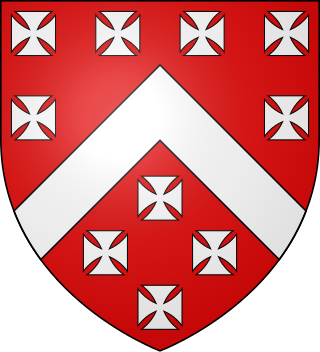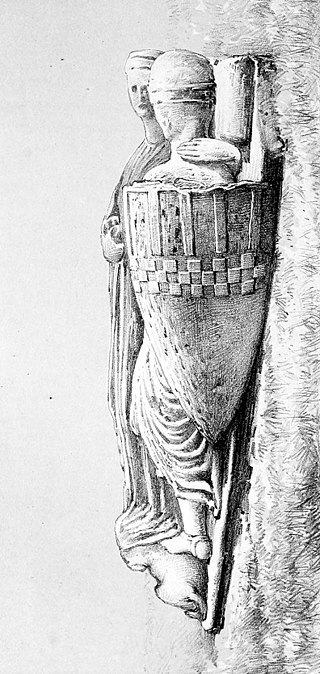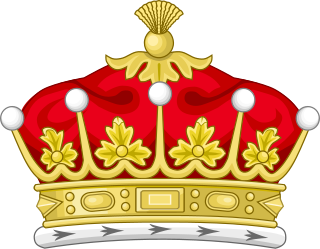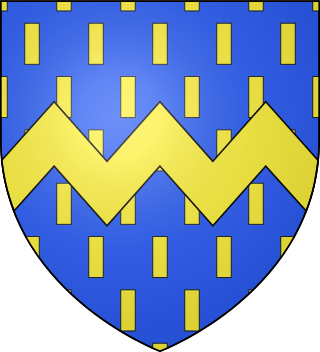This article needs additional citations for verification .(April 2017) |

Margaret Peverell, Countess of Derby (b. circa 1114, Nottinghamshire, England), was an English noblewoman who lived at Tutbury Castle in Staffordshire, England.
This article needs additional citations for verification .(April 2017) |

Margaret Peverell, Countess of Derby (b. circa 1114, Nottinghamshire, England), was an English noblewoman who lived at Tutbury Castle in Staffordshire, England.
Margaret was the daughter of William Peverel the Younger of Peveril Castle in Derbyshire [1] [2] [3]
According to Burke's Dormant, Abeyant, Forfeited and Extinct Peerages, she married Robert de Ferrers, 2nd Earl of Derby and thus became Countess of Derby. She was the mother of William de Ferrers, 3rd Earl of Derby and William De Ferrers, Lord of Eggington and a daughter, Petronella.{Burke's Dormant, Abeyant, Forfeited and Extinct Peerages}
She died in 1154 and was buried in Merevale Abbey.

William III de Ferrers, 5th Earl of Derby of Chartley Castle in Staffordshire, was an English nobleman and major landowner, unable through illness to take much part in national affairs. From his two marriages, he left numerous children who married into noble and royal families of England, France, Scotland and Wales.
Patrick IV, 8th Earl of Dunbar and Earl of March, sometimes called Patrick de Dunbar "8th" Earl of March, was the most important magnate in the border regions of Scotland. He was one of the Competitors for the Crown of Scotland.
Patrick III, 7th Earl of Dunbar was lord of the feudal barony of Dunbar and its castle, which dominated East Lothian, and the most important military personage in the Scottish Borders.
William Mauduit, 8th Earl of Warwick or William Maudit was an English nobleman and participant in the Second Barons' War.

The titles Baron Montacute or Baron Montagu were created several times in the Peerage of England for members of the House of Montagu. The family name was Latinised to de Monte Acuto, meaning "from the sharp mountain"; the French form is an ancient spelling of mont aigu, with identical meaning.

Edward le Despenser, 1st Baron Despenser was the son of another Edward le Despenser and Anne Ferrers, sister of Henry, Lord Ferrers of Groby. He succeeded as Lord of Glamorgan in 1349.

James Berkeley, 1st Baron Berkeley, also known as "James the Just", was an English peer.
Margaret de Audley,suo jure2nd Baroness Audley and Countess of Stafford was an English noblewoman. She was the only daughter of Hugh de Audley, 1st Earl of Gloucester, by his wife Lady Margaret de Clare. Her mother was the daughter of Joan of Acre, Princess of England; thus making Margaret a great-granddaughter of King Edward I by his first consort, Eleanor of Castile. As the only daughter and heiress of her father, she succeeded to the title of 2nd Baroness Audley [E., 1317] on 10 November 1347.

Walter Bailloch, also known as Walter Bailloch Stewart, was distinguished by the sobriquet Bailloch or Balloch, a Gaelic nickname roughly translated as "the freckled". He was the Earl of Menteith jure uxoris.

Earl of Oxford and Earl Mortimer was a title in the Peerage of Great Britain. It was created in 1711 for the statesman Robert Harley, with remainder, failing heirs male of his body, to those of his grandfather, Sir Robert Harley. He was made Baron Harley, of Wigmore in the County of Hereford, at the same time, also in the Peerage of Great Britain and with similar remainder as for the earldom. Harley was the eldest son of Sir Edward Harley and the grandson of the aforementioned Sir Robert Harley.
William of Salisbury, 2nd Earl of Salisbury was an Anglo-Norman peer. Though he is generally known as such, his proper title was Earl of Wiltshire, which title was conferred on his father by the Empress Matilda around 1143. He was also called William FitzPatrick. He was the son and heir of Patrick of Salisbury, Earl of Wiltshire, styled Earl of Salisbury, and of Ela Talvas.

Maurice FitzMaurice FitzGerald, 2nd Earl of Desmond was the son of Maurice FitzGerald, 1st Earl of Desmond, and his first wife, Catherine de Burgh.
Richard Grey, 3rd Earl of Tankerville, 8th Lord of Powys fought on the side of the House of York in the War of the Roses.

William Keith, 4th Earl Marischal was a Scottish nobleman and politician.
Thomas Cobham, de jure 5th Baron Cobham of Sterborough Castle, and from 1460 de jure 5th Baron Cobham, was an English nobleman.
Margaret Magennis, Viscountess Iveagh, also known as Margaret Butler, was the mother of John Butler, the de jure 15th Earl of Ormond. She is remembered by the song A Lament for Kilcash.

The Ferrers family were a noble Anglo-Norman family that crossed to England with the Norman Conquest and gave rise to a line that would hold the Earldom of Derby for six generations before losing it in rebellion. They also gave rise to several lines that held English peerages, the longest-living going extinct in the male line in the 15th century, as well as a Norman branch of the family that persisted into the 13th century. A French line persisted into the 16th century.
John Cochrane, 4th Earl of Dundonald, was a Scottish aristocrat and politician.

Edmund Deincourt, 1st Baron Deincourt, Lord of Thurgarton, Blankney and Branston was an English noble. He served in the wars in France and Scotland and was a signatory of the Baron's Letter to Pope Boniface VIII in 1301.
Margaret Longespée, 4th Countess of Salisbury was an English noblewoman.